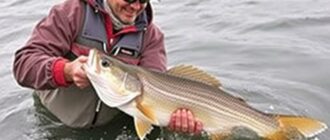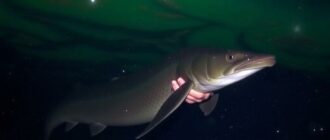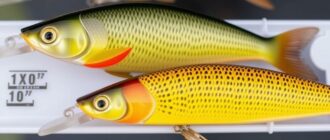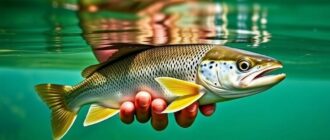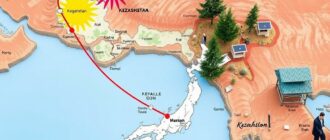Welcome — whether you are a complete beginner curious about the gentle art of fishing or a seasoned angler looking for new ways to enjoy brook trout waters, this long-form guide is written for you. “Forellenangeln in der Bachforestenregion” may sound like a phrase plucked from a map of German-speaking highlands, but the experiences it describes — clear stream riffles, dappled sunlight, patient casting, and the sudden thrill of a trout taking your fly — are universal. In the pages that follow you’ll find practical advice, scientific background, seasonal tactics, gear lists, conservation practices, recipes, stories, and checklists. I’ll walk you through the river, step by step, in an engaging, conversational style that keeps things simple without dumbing them down.
There are many ways to enjoy “Forellenangeln in der Bachforestenregion.” You can spend a meditative afternoon on a shaded bank listening to the water, or you can chase trophy fish with meticulous technique. Either way, the journey matters as much as the catch. If you like, read straight through for a full immersion; if you’re pressed for time, use the headings to hop to the sections you need. Either way, expect practical tips and real-world wisdom that you can take to the stream tomorrow.
What Does “Forellenangeln in der Bachforestenregion” Really Mean?
Put simply, the phrase translates roughly as “trout fishing in the brook trout region.” It evokes a place where small streams and creeks—habitat for brook trout and related species—shape the landscape and the way anglers interact with nature. These regions might be steep, rocky headwaters, gently meandering lowland creeks, or clear mountain runs. The specific species and techniques vary from place to place, but the core experience—careful observation, stealth, and an appreciation for the subtle behavior of trout—remains consistent.
When I say “region,” I mean more than geography. I’m describing a culture and an approach: small-stream finesse, lightweight tackle, and an ethic of respect for the water and its inhabitants. “Forellenangeln in der Bachforestenregion” isn’t just a pastime; it’s an invitation to slow down, learn from the river, and match your methods to the local trout’s habits.
As you read this guide, imagine yourself standing by a clear brook. Focus on the details: the slight ring in the water where a trout rises, the current lines between rocks, the tiny insects on the surface. These images will tie together the technical advice below with the feeling that makes trout fishing so addictive.
A Brief History: Human and Fish in Small Streams
Trout, humans, and small streams have a long history together. Across Europe and North America, native brook trout and their cousins have shaped local diets, folklore, and even settlement patterns. Small streams were once lifelines: sources of food, routes for trade, and scenic backdrops for communities. Anglers developed specialized methods that fit those waters—ultralight tackle, single-hook flies, and a deep knowledge of insect hatches.
Historically, “Forellenangeln in der Bachforestenregion” was as much about subsistence as it was about sport. People relied on clean, cold waters for protein. Over time, cultural attitudes shifted: fishing became a recreation, governments regulated stocks, and conservation science began to influence how we manage watersheds. Today, many small-stream regions are cherished for their ecological value and recreational opportunities, and local communities often work to balance access with protection.
In many countries, stocking programs introduced non-native trout species to create recreational fisheries. These efforts had mixed results—sometimes boosting short-term angling opportunities but also disrupting native populations and ecological balance. Modern management increasingly favors habitat restoration, catch-and-release, and species-appropriate approaches that support both anglers and native trout. That shift is central to responsible “Forellenangeln in der Bachforestenregion.”
Understanding Brook Trout Ecology: The Key to Smart Fishing
Before we talk technique, it’s useful to understand the trout’s world. Brook trout and related species are adapted to clear, cool, oxygen-rich water. Their distribution reflects temperature gradients, substrate types, and food availability. Trout are cold-blooded, so their activity level depends on water temperature—this fact alone shapes where and when you should fish.
Trout feed opportunistically. They eat aquatic insects—nymphs, emergers, and adults—terrestrial insects that fall into the water, small crustaceans, and occasionally small fish. Their feeding behavior changes with life stage and season, and keen anglers learn to “read” those shifts. Rather than forcing a single technique, effective trout fishing is about matching your presentation to the trout’s diet and the way prey moves in the current.
Habitat structure matters. Trout prefer certain combinations of depth, flow, and cover. Pools offer secure resting areas; riffles provide oxygen and food; runs are highways where trout hold and move. Woody debris, undercut banks, and boulder fields create ambush points. When you learn to recognize these features and their relationship to trout behavior, you dramatically improve your chances of catching fish.
Water Temperature and Trout Activity
Water temperature is perhaps the single most important environmental variable. Brook trout are most active in cold water—typically between about 50 and 60°F (10–15°C), though tolerances vary. When temperatures rise above their comfort zone, trout become lethargic and seek thermal refugia—cooler pockets under shade, deep pools, or groundwater inflows. Conversely, in very cold water they may feed less but still react to carefully presented offerings.
Modern anglers often monitor water temperature with portable thermometers or smartphone sensors. Understanding temperature trends across the day and season helps you choose tactics—early-morning nymphing during hot summers, for instance, or mid-day dry-fly slinging in cool spring conditions.
Food Webs and Insect Hatches
A trout’s stomach is a living index of its environment. Aquatic insects—mayflies, caddisflies, stoneflies—are very important. Each group has nymphal and adult stages that present opportunities for the angler. Mayflies, for example, hatch in large, predictable events called “hatches,” when trout gorge on abundant emergers and dries. Caddisflies often emerge at dusk, and stoneflies inhabit faster, oxygen-rich riffles. Terrestrial insects—beetles, ants, grasshoppers—fall into the water and provide rich, often overlooked meals.
To be a successful angler, treat the stream as a dynamic restaurant: what’s on the menu changes with time of day, season, and weather. When you can identify the major food sources and anticipate hatch schedules, you can present flies and baits that match the trout’s current preferences.
Essential Gear for Small-Stream Trout Fishing
One of the best aspects of “Forellenangeln in der Bachforestenregion” is how accessible it can be. You don’t need massive boats or heavy tackle; finesse and suitable gear win the day. Below is a practical overview of essential equipment and why each piece matters.
When shopping, focus on simplicity and durability. A well-chosen setup is more effective than a hodgepodge of gadgets. Spend on a quality rod and reel combo that matches the waters you plan to fish. The rest—flies, leaders, waders—should complement that choice.
Rods, Reels, and Lines
For fly fishing, a 2 to 6-weight rod (length 7’6″ to 9′) is ideal for small streams. Lighter rods amplify presentation, making it easier to cast delicate dries and manage short, technical casts. A versatile 3- or 4-weight is often the sweet spot. Match your reel to the rod, with a smooth drag system and enough spool capacity to hold whatever floating or thin sinking line you prefer.
For spinning, a medium-light to light spinning rod in the 6’6″ to 7′ range with 2–6 lb test line covers most scenarios. Use high-quality braided or fluorocarbon lines for improved sensitivity and control. If you prefer bait fishing, consider a longer rod for better hooksets and line control, and use lighter line to avoid spooking cautious trout.
Leaders, Tippets, and Terminal Tackle
In fly fishing, leader taper and tippet diameter affect presentation. Use a 7.5–9 foot tapered leader for most small-stream work, and switch tippet sizes based on fly and trout wariness—6X or 5X for spooky fish, 3X or 4X for general work. For nymphing, a stiffer fluorocarbon bite tippet in 4X–6X helps transmit strikes and resist abrasion.
Spinning anglers should use light fluorocarbon leaders because they sink and are less visible underwater. Small swivels, split shot, and tiny snaps are useful for setting up rigs, but keep everything neat and minimal—streamside clutter spooks trout.
Waders, Boots, and Clothing
Waders are optional for small streams but incredibly useful for getting off the bank. Breathable chest waders keep you dry and comfortable; hip waders are lighter and fine for shallow runs. Boots with sticky rubber soles provide traction on mossy rocks. Dressing in layers—moisture-wicking base layers, insulated mid-layers, and waterproof shells—lets you stay comfortable as weather changes.
Always carry a hat for sun and glare protection, polarized sunglasses to see through surface glare and spot trout, and a pack or vest to organize flies, leaders, and pliers. A small first-aid kit, insect repellent, and sunscreen round out your essentials.
Gear Comparison: A Quick Table
| Purpose | Recommended Fly Setup | Recommended Spin/Bait Setup |
|---|---|---|
| Light Small Streams | 3–4 wt fly rod, floating line, 7.5–9ft leader, 5X tippet | 6’6″ light spinning rod, 4–6 lb test, small spoons/spinners, light fluorocarbon leader |
| Medium Runs & Pools | 4–5 wt rod, floating or light sink-tip, nymph rig or dry-dropper | 7′ medium-light spinning rod, 6–8 lb test, small soft plastics, marabou jigs |
| Cold, Fast Riffles | 3–4 wt, heavier nymphs and split shot, 4X tippet for abrasion resistance | Medium spinning rod, 6 lb test, inline spinners and heavy nymph imitations |
| Warm Season Surface Feeding | 3–5 wt, dry flies and emerger patterns, long leaders (9ft) and 6X tippet | Light spinning rod, 4–6 lb test, small topwater lures (beetle imitators) |
Techniques: How to Catch More Trout
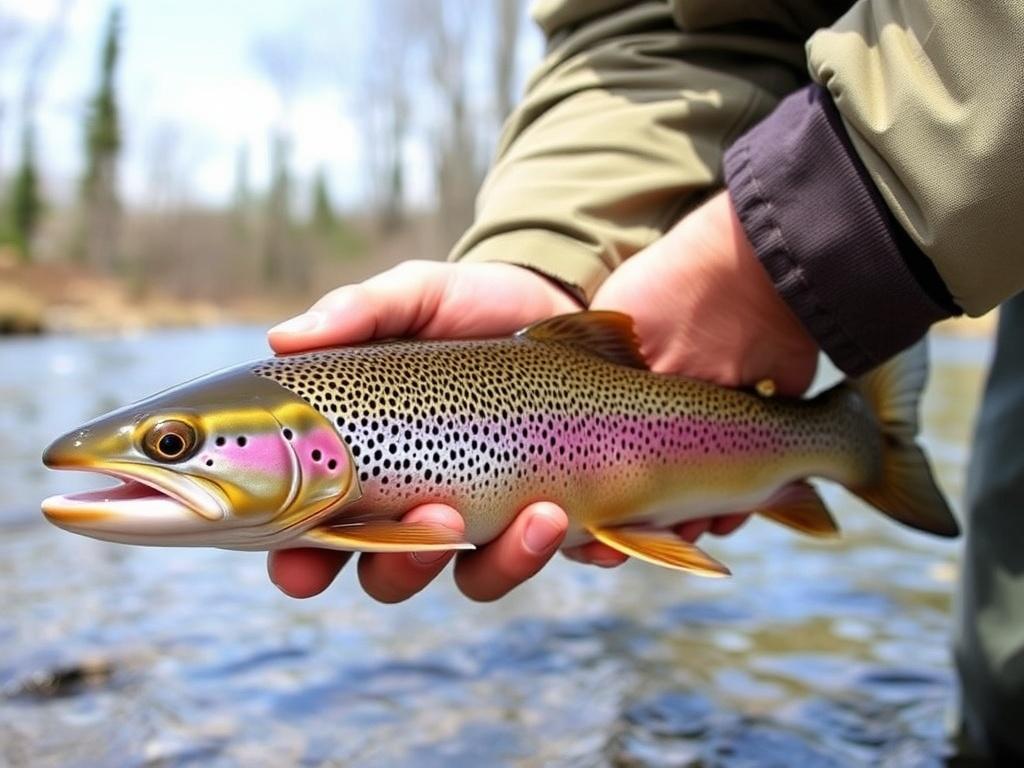
Trout in small streams are intelligent in their own fishy way. They notice shadows, strange ripples, and unnatural movement. The best anglers blend stealth, presentation, and timing. Below are practical techniques that work in many “Forellenangeln in der Bachforestenregion” situations.
I’ll cover fly-fishing and spinning techniques separately, but remember that the principles—matching the drift or presentation to the natural movement of prey and keeping the fish unspooked—remain the same regardless of method.
Dry Fly Fishing: Magic on the Surface
Few sensations match the thrill of a trout sipping a dry fly from the surface. Dry-fly fishing is especially effective during insect hatches when trout are keyed into surface food. Key points: use light leaders and tippets, make long drag-free drifts, and mend line to keep the fly drifting naturally.
Approach: Move quietly and keep a low profile. Cast slightly upstream and let your fly drift past the trout’s lie. If you notice drag (unnatural pulling of the fly), perform a gentle mend upstream so the fly moves naturally with the current. When a trout takes the fly, wait a second—often the trout will mouth the fly before committing—and then set the hook with a gentle but firm lift of the rod.
Nymphing: The Workhorse Technique
Nymphing—fishing subsurface nymphs that imitate immature aquatic insects—is often the most productive technique in small streams. Trout feed below the surface much of the time, so nymphing lets you target their stomach-level activity. Use indicators (strike floats), tight-line Euro-style nymphing, or a dry-dropper rig (a dry fly floating above a nymph) depending on flow and depth.
Effective nymphing requires attention to depth and drift. Add split shot if the nymph rides too high, or use heavier bead-headed flies if you need to get deep. Remember to vary drift speed and depth until you get strikes. Many trout take nymphs aggressively but subtly, so watch your line and rod tip carefully for any movement.
Streamers and Larger Patterns
Streamers mimic small baitfish, sculpins, and leeches. They work well when trout are more territorial or during low-light conditions like dawn and dusk. Streamer fishing is more active: cast across the current and retrieve with short strips, pauses, and figure-eight motions near the rod tip when a strike occurs. Streamers are less about stealth and more about provoking a reaction bite.
Use weighted streamers or add split shot to get deeper presentations. Larger streamers can draw out substantial trout, but be ready for hard runs and strong hooksets—especially in larger waters where fish are feistier.
Spinning Techniques: Lures and Baits
If you’re using a spinning rod, small spoons, inline spinners, marabou jigs, soft plastics, and tiny crankbaits are effective. Spinners and spoons flash and vibrate, attracting trout in slightly murkier water or faster flows. Soft plastics and jigs can be dragged along the bottom, imitating leeches or nymphs.
For bait fishing, natural baits like worms, salmon eggs, or small cooked shrimp work well. Use light rigs and small hooks to match the trout’s mouth size. Be mindful of local regulations regarding bait and hooks—barbless hooks and single hooks are often required in conservation-minded waters.
Reading the Water: Where Trout Like to Hide
Knowing where trout are likely to be is as important as your casting skill. Here are the basic features to look for and why trout favor them:
- Pools: Deep, slow-moving water offers refuge and energy conservation. Trout rest here, often near the head or tail where food drifts in.
- Riffles: Shallow, fast water with oxygen-rich flow. Nymphs thrive here; trout often feed along the edges.
- Runs: Smooth flow between riffles and pools where trout hold in current seams.
- Undercut Banks and Root Wads: Provide cover from predators and current; trout often sit with just their heads exposed.
- Structure: Rocks, submerged logs, and vegetation create ambush opportunities.
When you approach water, think of current seams (where slow water meets faster water) as highways that funnel food. Trout sit just below the seam to conserve energy and intercept food items. Fish along the seam, behind rocks, or at the tail ends of pools, and use presentations that drift naturally from the seam toward the trout.
Tactics for Each Season: Timing Your Approach
Seasons shape trout behavior. A smart angler adapts. Below I’ll walk through spring, summer, fall, and winter strategies for small streams in “Forellenangeln in der Bachforestenregion.”
Spring: Hunger and High Water
Spring brings increased activity. As water temperatures rise, trout become more active after a lean winter. Snowmelt and heavy rains can raise flows—this can make some spots difficult to fish but also concentrates prey in calmer pockets. Focus on the edges of faster flows and the seams below riffles. Nymphing works well, and during warm spells you may find excellent dry-fly action as insects hatch.
When flows are high, use larger nymphs or add split shot so your fly gets down to where the fish are holding. In early spring, prioritize stealth as trout can be wary after winter recovery.
Summer: Pressure and Heat
Summer is often the trickiest season for small-stream trout. High air temperatures raise water temperatures, pushing trout to seek cool refuges. Fish in early morning and late evening when temperatures are lower. Look for shaded runs, deep pools, and springs where groundwater keeps temperatures down. Dry-fly fishing can be spectacular in the evenings when terrestrial insects fall into the water.
Around midday, focus on deep pools and undercut banks. Use light tippets for picky fish, and remember that trout are less willing to expend energy in warm water—a subtle presentation often outperforms heavy attraction tactics.
Autumn: Feeding Up for Winter
Autumn sees trout feeding aggressively as they bulk up for winter. Cooler water invigorates their appetite, and insect hatches and terrestrial input can be robust. Dry-fly and nymphing tactics both produce well. Look for consistent feeding in pools and runs, and expect energetic strikes as trout take advantage of the bounty before cold weather slows them down.
Redds (spawning gravel) may be present for some species—avoid disturbing spawning fish and follow local regulations about closed seasons. Autumn is also a great time to explore because the landscape often sheds leaves and brush, making access easier.
Winter: Slow and Patient
Winter trout fishing requires patience. Cold water slows trout metabolism, and they feed less often. Fish deep and slow, using smaller flies and slower retrieves. Midday is usually your best bet when water temperatures peak. Nymphs and small streamers often work best. Dress warmly and pay extra attention to safety—slick banks and thin ice present hazards.
Winter can be surprisingly rewarding because angling pressure is lower and trout can be bolder in certain situations, particularly when clear, cold days follow stable weather.
Conservation, Ethics, and Catch-and-Release Best Practices
If you love trout fishing, you must love the waters that sustain trout. That requires ethical behavior and a commitment to conservation. “Forellenangeln in der Bachforestenregion” thrives when anglers prioritize long-term health of fish populations and habitats.
Catch-and-release is an effective tool when done correctly. Use barbless hooks or crimp barbs, wet your hands before handling fish, minimize air exposure, and revive exhausted fish in current before release. Handle fish gently and avoid squeezing or touching gills. If you plan to harvest, follow local size and bag limits, and only take what you can ethically and legally consume.
Reducing Harm: Tackle and Handling Tips
Choose tackle that allows quick control of fish—if a trout struggles for a long time while you try to land it, its chance of surviving after release drops. Use strong but appropriately light tippets and rods that give you leverage while avoiding excessive fight times. Consider using rubber nets which reduce slime damage, and avoid nets if they cause prolonged handling.
When netting a fish, keep it in the water and remove the hook quickly with forceps. If the hook is deeply swallowed, cut the line as close as possible rather than forcibly removing it—most hooks will corrode or work loose and leaving a hook is often less damaging than prolonged internal injury.
Habitat Protection and Responsible Access
Protecting the stream corridor—riparian vegetation, shading trees, and gravel beds—is critical. Walk carefully, stick to established trails, and avoid trampling sensitive banks that prevent erosion. If you see trash, take it with you; if you encounter survey or restoration projects, respect signage. Participate in local conservation efforts when possible; many communities offer volunteer restoration days that rebuild habitat and improve fishing in a lasting way.
Follow local rules about access and stewardship. Many regions have public angles and private waters; always obtain permission before crossing private land. The angling community thrives on trust and respect; being a good guest keeps access open for everyone.
Safety in the Field: Practical Precautions
Small streams can be deceptively dangerous. Slippery rocks, sudden water rises, and remote locations mean you should take safety seriously. Inform someone where you’ll be fishing, check weather forecasts, carry a fully charged phone or satellite messenger if you’re in remote areas, and know basic first aid. If you wear waders, always follow safe wading techniques: use a wading staff, face upstream, cross at shallow points, and unbuckle chest waders when not in deep water to avoid entrapment risk.
Respect wildlife—snake encounters, bears, and other animals are possible in some regions. Make noise in thick brush, store food properly, and carry bear spray where appropriate. Finally, learn simple rescue skills in case someone slips or suffers a hypothermic shock in cold water conditions.
Recipes: From Stream to Table
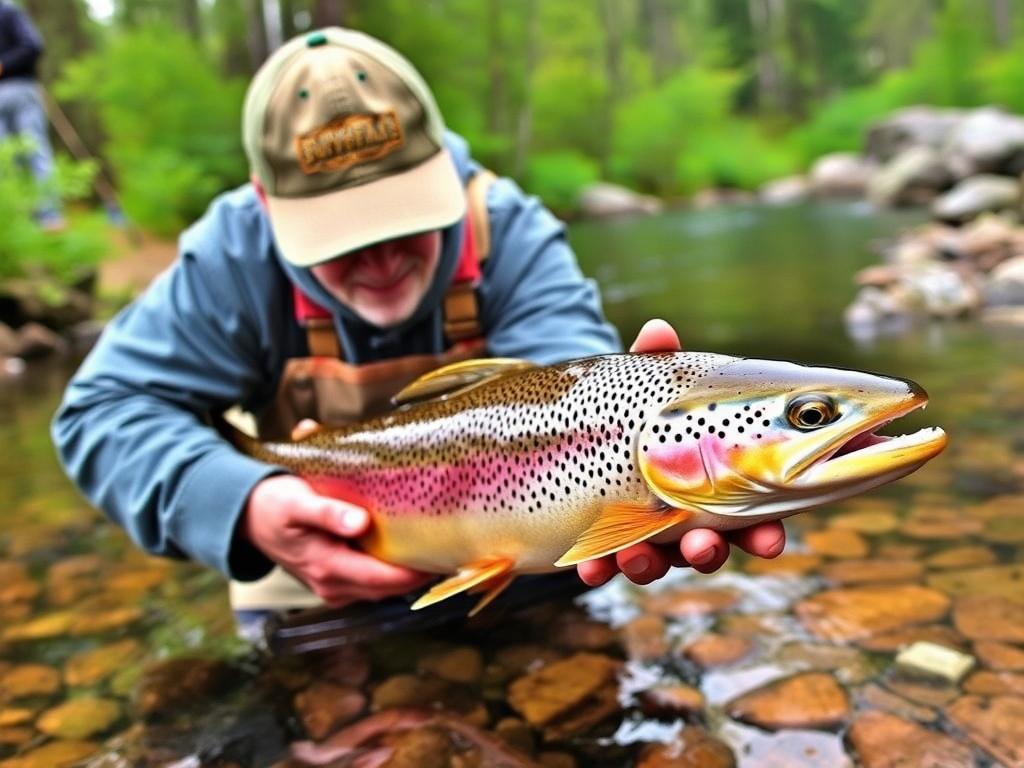
Part of the charm of trout fishing is harvesting a fish and preparing it simply and well. If you decide to keep a trout or two, here are basic, delicious methods that celebrate the delicate flavor of freshwater trout.
Simple Pan-Fried Trout
Ingredients: fresh trout (cleaned and gutted), butter or oil, salt, pepper, lemon, optional fresh herbs (parsley, dill, thyme).
Method: Rinse and pat dry. Season inside and out with salt and pepper. Heat a skillet with butter or oil until hot. Cook trout 3–4 minutes per side depending on size, basting with melted butter. Finish with a squeeze of lemon and fresh herbs. Serve with roasted potatoes or a simple salad.
Grilled Whole Trout on the Campfire
Ingredients: whole trout, olive oil, salt, pepper, lemon slices, fresh rosemary or thyme, foil if desired.
Method: Oil the fish lightly and season. Stuff cavity with lemon and herbs. Wrap loosely in foil or place directly on a grill grate. Cook over medium coals about 10–12 minutes until flesh flakes easily. Enjoy outdoors with bread and wild greens.
Stories, Anecdotes, and the Soul of the Stream
Trout fishing is full of small revelations: a child’s first catch, an old angler’s secret favorite bend, the way a river remembers seasons. Here are short tales and reflections to remind you why so many people return to these waters year after year.
Once, on a foggy morning, I met a retired teacher kneeling on a mossy bank. She had been fishing the same stretch of creek for decades. She spoke of learning the water’s moods like a book—when the riffle would hiss with stoneflies, when the upper pool took to surface feeding after rain. Her trophies were less important than knowing the place intimately. That sense of belonging is a hallmark of “Forellenangeln in der Bachforestenregion.”
Another time, I spent a summer afternoon fishing with a friend who swore by a single, battered fly pattern—it had caught more trout on that stream than any other fly. She treated the fly like an old tool, repairing its head and tying it with care. When it finally disappeared into a deep, tangle of roots, she felt like she had lost a companion. Such small relationships—with gear, with specific pools, and with the fish—are part of the emotional texture of trout fishing.
Planning Your Fishing Trip: Practical Steps
Ready to plan a day or a weekend in the brook trout region? Here’s a practical checklist to make your trip smooth and enjoyable.
Trip Checklist
- Permits and Licenses: Confirm you have the correct regional licenses and any local permits. Note seasonal restrictions.
- Weather and Water Levels: Check forecasts; consider recent rainfall and streamflow reports.
- Maps and Access: Download offline maps, know access points, and respect private property boundaries.
- Gear: Rod/reel, lines, flies/lures, leaders/tippets, waders/boots, hat, polarized sunglasses, net, forceps, measuring device.
- Safety: First aid kit, phone/communication device, whistle, wading staff, warm layers.
- Food and Water: Hydration and easy-to-eat snacks, and bear-safe storage if necessary.
- Conservation Tools: Trash bag, small towel for wet hands, hand sanitizer.
Leave an itinerary with someone where you’re staying and plan for variable conditions. Arrive early to maximize low-light feeding windows, and give yourself time to explore different runs and pools instead of expecting instant success.
Common Problems and How to Fix Them
Even the best-laid plans meet obstacles. Here are common small-stream fishing problems and straightforward fixes.
Problem: Trout Spook When You Approach
Solution: Move off the obvious path, approach slowly and low, cross the stream at a distance, and cast from different angles. Hide behind vegetation or rocks to break your outline. Stay quiet and limit sudden movements.
Problem: The Fly Keeps Dragging
Solution: Mend line upstream or downstream to keep the fly drifting naturally. Shorten your leader if necessary, use a longer leader for delicate dries, or add a small dry fly upstream as an indicator to reduce drag on a dropper.
Problem: No Strikes Despite Good Presentation
Solution: Change fly size or color, try a different fly stage (nymph vs. emerger), fish a different depth, or alter retrieve speed. Switch from single fly to double-nymph setups or try an attractor pattern to provoke reaction strikes.
Useful Lists and Resources
Below are lists of handy flies, nymph patterns, and streamside tools that are especially effective in small-stream trout waters. Keep these in your vest when you’re sampling streams in “Forellenangeln in der Bachforestenregion.”
Essential Dry Fly Patterns
- Adams (general mayfly imitation)
- Pheasant Tail (when tied as an emerger/secondary)
- Elk Hair Caddis (caddis imitation)
- Parachute patterns (high visibility for tricky situations)
- Small beetle/ant imitations (for terrestrial-feeding trout)
Essential Nymph Patterns
- Pheasant Tail Nymph (PTN)
- Hare’s Ear (general nymph)
- CDC emergers (imitation of mayfly emergers)
- Bead-head nymphs in sizes 12–18 for getting down quickly
- Stonefly nymphs in sizes 8–14 for fast riffles
Essential Streamside Tools
- Forceps/pliers for hook removal
- Polarized sunglasses to reduce glare
- Wading staff for balance
- Small rule or fish-safe measuring device
- Rubber net with knotless mesh
Regulations and Local Considerations
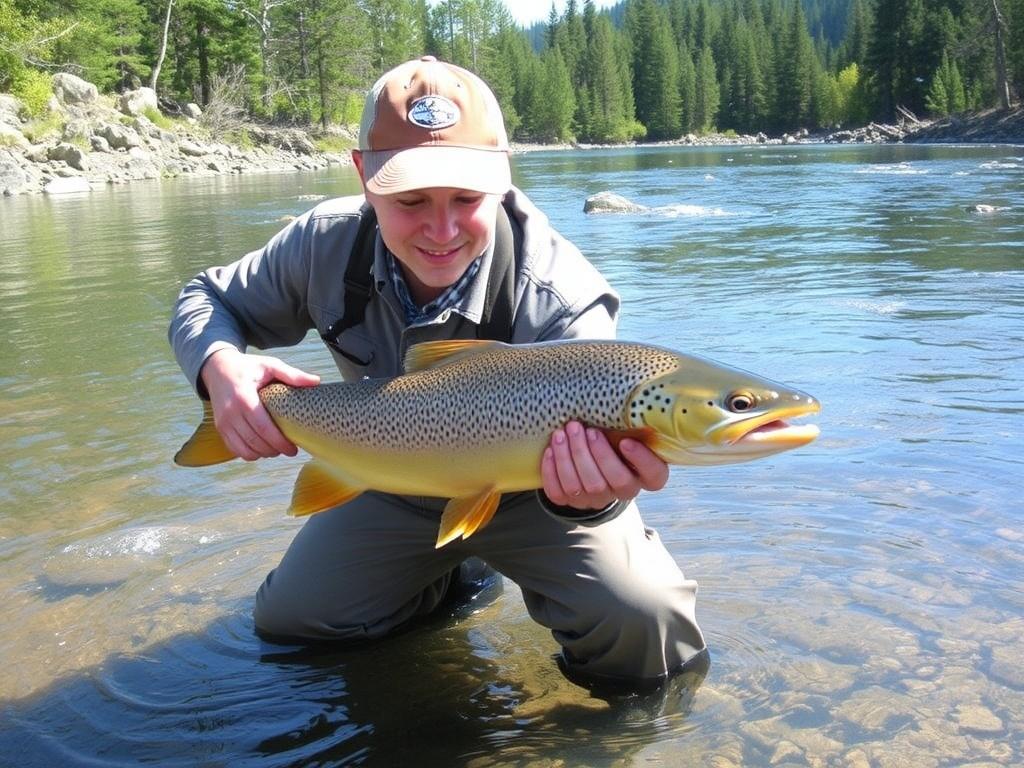
Fishing laws vary widely. Before you go, check regional rules for licenses, size and bag limits, closed seasons, and gear restrictions. Some streams may be catch-and-release only, or barbless hooks may be mandatory. Respecting these regulations is essential to conserving fish populations and maintaining access for the future.
In many brook trout regions, local angling clubs and conservation groups maintain information boards or online resources about current stream conditions and regulations. Reach out to them—they often provide invaluable, up-to-date local knowledge.
Advanced Tips: Subtle Techniques for Selective Fish
Once you’ve mastered the basics, you can refine your approach with advanced techniques that address the nuance of picky trout. Patience, observation, and small adjustments yield big rewards.
Matching the Hatch Exactly
If trout are taking a very specific insect, match size, color, and posture as closely as possible. Watch the insects—note their wing shape, body color, and how they sit on the water. Sometimes a half-size difference matters in selective waters. Use emergers when trout are nipping beneath the surface film, and small droppers when fish are holding slightly subsurface.
Presentation and Line Management
Practice roll casts, off-hand casts, and tight-line techniques to reduce splash and line drag. Learn to “mend” discrete line portions without spooking trout, and to lay down leaders silently. Creed is less about heroic casts and more about the finesse of line control.
Seasonal Micro-Locations
Learn local micro-habitats: where small tributary inflows cool the water on hot days, where beaver ponds influence current and structure, and how seasonal leaf fall changes cover. Best anglers act like detectives, piecing together clues from insect life, water color, and nearby habitat to predict trout locations.
Glossary of Helpful Terms
| Term | Meaning |
|---|---|
| Drift | The movement of a fly or bait downstream; a natural drift imitates real prey movement. |
| Mend | A line adjustment made after the cast to change drift speed and eliminate drag. |
| Riffle | Shallow, fast-flowing section of a stream with broken water and oxygen-rich flow. |
| Pool | Deep, slow-moving area where trout rest and conserve energy. |
| Tippet | Final thin section of leader to which the fly is tied; thinner tippets are less visible. |
Frequently Asked Questions (FAQs)
What is the best time of day to fish small streams?
Early morning and late evening are often best, especially in warm seasons. Midday can work in spring and autumn when temperatures are cooler. Always consider insect activity and water temperature when choosing your time.
Do I need a boat for trout in these regions?
No. Many brook trout habitats are shallow and best fished on foot. Wading or fishing from the bank provides better access to the structure trout use.
How do I avoid getting my flies snagged on the bottom?
Use lighter weights, shorter casts, and better drift control. For nymphing, adjust split shot placement and use thinner leaders to reduce hang-ups. Learn to detect strike signatures that are actually snags—feel and observe. Practice retrieving slowly when you suspect a snag to avoid breaking off and losing flies.
Final Thoughts: The Quiet Joy of “Forellenangeln in der Bachforestenregion”
Trout fishing in brook trout regions is an intimate conversation between angler, water, and fish. It’s a pursuit that rewards observation, humility, and patience. Every outing—every cast—teaches you something about currents, insects, weather, and, most importantly, how to read the subtle cues trout give. The techniques and gear discussed here will help you make more connections with these secretive fish, but the real mastery comes from spending time on the stream, listening, and learning.
Whether you prefer the delicate artistry of dry-fly fishing, the reliable productivity of nymphs, or the thrill of a streamer-taken surprise, embrace the flow of the water and the rhythms of the seasons. Respect the stream, observe local regulations, and pass on the traditions of conservation and good stewardship. In doing so, you’ll not only improve your own skill but also ensure that the “Forellenangeln in der Bachforestenregion” remains a treasured experience for future generations.
Now lace up those wading boots, tie on a favorite fly, and step quietly into the next run. The brook remembers those who treat it kindly—and it will reward you, in ways both expected and wonderfully surprising.

